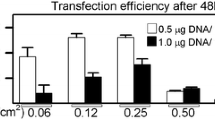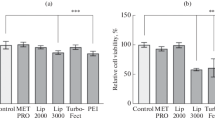Abstract
With the advent of recent protocols to isolate multipotent human mesenchymal stem cells (MSCs), there is a need for efficient transfection methodologies for these cells. Most standard transfection methods yield poor transfection efficiencies for MSCs (<1%). Here we have optimized a high-efficiency transfection technique for low passage MSCs derived from adult human bone marrow. This technique is an extension of electroporation, termed amaxa Nucleofection™, where plasmid DNA is transfected directly into the cell nucleus, independent of the growth state of the cell. With this technique, we demonstrate up to 90% transfection efficiency of the viable population of MSCs, using plasmid construct containing a standard cytomegalovirus (CMV) early promoter driving expression of green fluorescent protein (GFP). Although little variation in transfection efficiency was observed between patient samples, a 2-fold difference in transfection efficiency and a 10-fold difference in expression levels per cell were seen using two distinct CMV-GFP expression plasmids. By fluorescence-activated cell sorting, the GFP expressing cells were sorted and subcultured. At 2 wk posttransfection, approx 25% of the population of sorted cells were GFP positive, and by 3 wk, nearly 10% of the cells still retained GFP expression. Transfection of these cells with plasmid containing either the collagen type I (Colla1) promoter or the cartilage oligomeric matrix protein (COMP) promoter, each driving expression of GFP, produced a somewhat lower transfection efficiency (approx 40%), due in part to the lower activity of transcription from these promoters compared to that of CMV. Transfection with the collagen type II (Col2a1) promoter linked to GFP exhibited low expression, due to the fact that collagen type II is not expressed in these cells. Upon culturing of the Col2a1-GFP transfected cells in a transforming growth factor-β3-containing medium known to induce mesenchymal chondrogensis, a significant enhancement of GFP level was seen, indicating the ability of the transfected cells to differentiate into chondrocytes and express cartilage-specific genes, such as Col2a1. Taken together, these data provide evidence of the applicability of this technique for the efficient transfection of MSCs.
Similar content being viewed by others
References
Owen, M. and Friedenstein, A. J. (1988) Stromal stem cells: marrow-derived osteogenic precursors. Ciba Found. Symp. 136, 42–60.
Herzog, E. L., Chai, L., and Krause, D. S. (2003) Plasticity of marrow-derived stem cells. Blood 102, 3483–3493.
Caterson, E. J., Nesti, L. J., Danielson, K. G., and Tuan, R. S. (2002) Human marrow-derived mesenchymal progenitor cells: Isolation, culture expansion, and analysis of differentiation. Mol. Biotechnol. 20, 245–256.
Huard, J., Cao, B., and Qu-Petersen, Z. (2003) Musclederived stem cells: potential for muscle regeneration. Birth Defects Res. Part C Embryo Today 69, 230–237.
Zuk, P. A., Zhu, M., Ashjian, P., De Ugarte, D. A., Huang, J. I., Mizuno, H., et al. (2002) Human adipose tissue is a source of multipotent stem cells. Mol. Biol. Cell. 13, 4279–4295.
Gimble, J. M. and Guilak, F. (2003) Differentiation potential of adipose derived adult stem (ADAS) cells. Curr. Top. Dev. Biol. 58, 137–160.
Noth, U., Osyczka, A. M., Tuli, R., Hickok, N. J., Danielson, K. G., and Tuan, R. S. (2002) Multilineage mesenchymal differentiation potential of human trabecular bone-derived cells. J. Orthop. Res. 20, 1060–1069.
Osyczka, A. M., Noth, U., Danielson, K. G., and Tuan, R. S. (2002) Different osteochondral potential of clonal cell lines derived from adult human trabecular bone. Ann. N. Y. Acad. Sci. 961, 73–77.
Tuli, R., Seghatoleslami, M. R., Tuli, S., Danielson, K. G., and Tuan, R. S. (2003) A simple, high-yield method for obtaining multipotential mesenchymal progenitor cells from trabecular bone. Mol. Biotechnol. 23, 37–49.
Tuli, R., Tuli, S., Seghatoleslami, M. R., Wang, M. L., Hozack, W. J., Manner, P. A., et al. (2003) Long-term culture expansion, growth kinetics, and multilineage potential of mesenchymal progenitor cells derived from human trabecular bone. Stem Cells 21, 681–693.
Johnstone, B., Hering, M. H., Caplan, A. I., Goldberg, V. M., and Yoo, J. U. (1998) In vitro chondrogenesis of bone marrow-derived mesenchymal progenitor cells. Exp. Cell. Res. 238, 265–272.
Pittenger, M. F., Mackay, A. M., Beck, S. C., Jaiswal, R. K., Douglas, R., Mosca, J. D., et al. (1999) Multilineage potential of adult human mesenchymal stem cells. Science 284, 143–147.
Mackay, A. M., Beck, S. C., Murphy, J. M., Barry, F. P., Chichester, C. O., and Pittenger, M. F. (1998) Chondrogenic differentiation of cultured human mesenchymal stem cells from marrow. Tissue Eng. 4, 415–428.
Osyczka, A. M., Danielson, K. G., Noth, U., Yoon, K., Caterson, E. J., and Tuan, R. S. (2002) Multi-lineage differentiation of adult human bone marrow stromal cells transduced with human papilloma virus16 E6/E7 genes. Calcif. Tiss. Int. 71, 447–458.
Tuan, R. S., Boland, G., and Tuli, R. (2003) Mesenchymal stem cells and cell-based tissue engineering. Arthr. Res. Ther. 5, 32–45.
Goins, W. F., Wolfe, D., Krisky, D. M., Bai, Q., Burton, E. A., Fink, D. J., and Glorioso, J. C. (2004) Delivery using herpes simplex virus: an overview. Methods Mol. Biol. 246, 257–299.
Coonrod, A., Li, F. Q., and Horwitz, M. (1997) On the mechanism of DNA transfection: efficient gene transfer without viruses. Gene Ther. 4, 1313–1321.
Hamm, A., Krott, N., Breibach, I., Blindt, R., and Bosserhoff, A. K. (2002) Efficient transfection method for primary cells. Tissue Eng. 8, 235–245.
Osaki, M., Tan, L., Choy, B. K., Yoshida, Y., Cheah, K. S., Auron, P. E., and Goldring, M. B. (2003) The TATA-containing core promoter of the type II collagen gene (COL2A1) is the target of interferon-gamma-mediated inhibition in human chondrocytes: requirement for Stat1 alpha, Jak1 and Jak2. Biochem. J. 369, 103–115.
Kubota, K., Okazaki, J., Louie, O., Kent, K. C., and Liu, B. (2003) TGF-beta stimulates collagen (I) in vascular smooth muscle cells via a short element in the proximal collagen promoter. J. Surg. Res. 109, 43–50.
Deere, M., Rhoades Hall, C., Gunning, K. B., LeFebvre, V., Ridall, A. L., and Hecht, J. T. (2001) Analysis of the promoter region of human cartilage oligomeric matrix protein (COMP). Matrix Biol. 19, 783–792.
Bowles, J., Schepers, G., and Koopman, P. (2000) Phylogeny of the SOX family of developmental transcription factors based on sequence and structural indicators. Dev. Biol. 227, 239–255.
Tuli, R., Tuli, S., Nandi, S., Huang, X., Hozack, W.J., Danielson, K.G., et al. (2003) TGF-b1 mediated chondrogenesis of human mesenchymal progenitor cells involves N-cadherin and MAP kinase and Wnt signaling crosstalk. J. Biol. Chem. 278, 41227–41236.
Author information
Authors and Affiliations
Corresponding author
Rights and permissions
About this article
Cite this article
Haleem-Smith, H., Derfoul, A., Okafor, C. et al. Optimization of high-efficiency transfection of adult human mesenchymal stem cells in vitro. Mol Biotechnol 30, 9–19 (2005). https://doi.org/10.1385/MB:30:1:009
Issue Date:
DOI: https://doi.org/10.1385/MB:30:1:009




